''Nureyev by Serebrennikov looks selfish''
The review on Nureyev ballet at the Bolshoi Theater in Moscow by Sergey Korobkov
In Kazan, where the International Classic Ballet Festival named after Rudolf Nureyev in the upcoming summer is going to be held for the 31st time, there have thought about staging a play about the outstanding dancer of the twentieth century. In 1992, he gave his name to the prestigious Russian dance forum, founded by director of the Theatre named after Musa Dzhalil Rafael Mukhametzyanov. The Bolshoi Theatre, which staged the long-awaited premiere for ballet lovers, has outpaced Kazan, but has not closed the topic, Moscow critic and permanent host of the festival named after Nureyev in the capital of Tatarstan Sergey Korobkov believes. He shared his impression from the ballet Nureyev in the article written specially for Realnoe Vremya.
Postponed to refine?
There have been many debates around the recent premiere in the Bolshoi Theatre. In June, before the close of the season, the play was postponed indefinitely, the unprecedented decision of the directorate was explained by that the work of composer Ilya Demutsky, librettist, director and scenography author Kirill Serebrennikov and choreographer Yury Posokhov needed improvement.
In the busy schedule of the main music scene of the country there finally were found a few days in December, but Nureyev ballet was already staged without its mastermind — Serebrennikov, placed under house arrest on the infamous case of the contemporary art project Platforma. As a result, when the premiere saw the footlights, many critics and public figures explained its postponement by purely political considerations, and saw in the fate of the main character, once made his famous leap to freedom, the similarity with the situation that has developed around the director and continues to stir up the society.
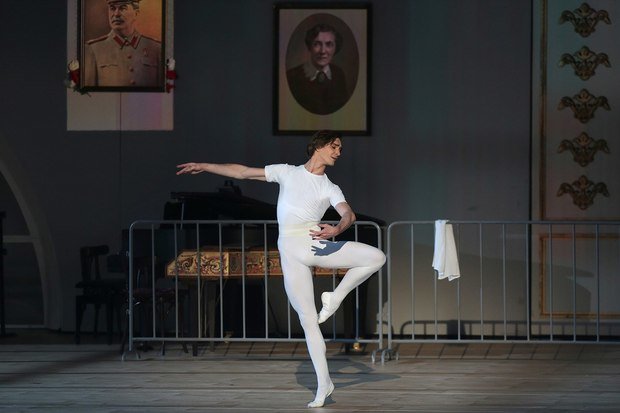
Meanwhile, the compound play even after the publication raises a number of questions, allowing to believe that it was sent for improvement solely for professional, not for any other, reasons. The image of the main character is complex, and alas, not fully revealed. The dramatic composition is also complex, where at first the retrospective action is transferred to on line format, then it is complicated with cinematic techniques of flash back (recollection of what once happened) and flashforward (sudden transition from sequential narration to the future) — and all this sometimes confuses storylines. The very structure of the stage material is also challenging, where along with the ballet as such there are actively involved, and sometimes prevail, means of expression borrowed from adjacent theater types.
From drama theatre — the character called Auctioneer/Avedon/Gray, and he constantly comments on what is happening as if from the outside: leads the auction, opening the performance, where for sale it was offered the legacy of Nureyev, from his school notebooks and diaries to antiques and the Li Galli Islands; he reads the extracted documents from the KGB archives and the addressed to 'the flying Tatar' from 2017 letters from Laurent Hilaire, Charles Jude, Alla Osipenko and Natalia Makarova.
From musical theater it was 'recruited' the whole choir with the soloist, named as Mezzo-soprano/Vahtersha/Wind. Under whose song in the manner of Lyudmila Zykina and the poems by Margarita Aliger, the director takes the action from the class of the ballet school, where by patter it was marked the turning of Nureyev-student into Nureyev-soloist of the Leningrad Theatre named after Kirov, to Paris–Le Bourget Airport, terminating the domestic period of the biography of the artist.
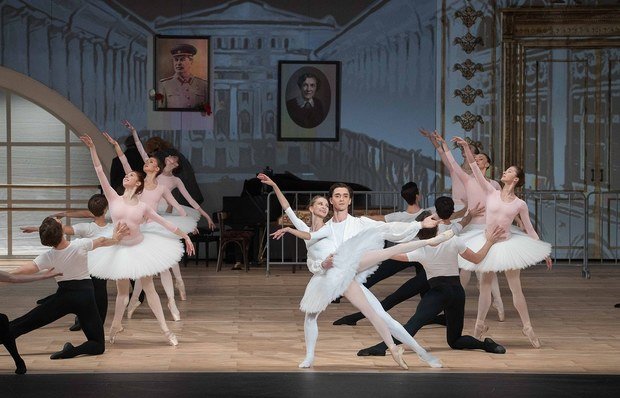
The king and them
And immediately — to Paris, shown almost grotesquely, through jazz dancers dressed in prêt à porter couples and the picture in the Bois de Boulogne with its inhabitants — transvestites tempting the breathed the air of freedom rebel. All this is accompanied by active comments of multimedia wing. The united and closed scenographic installation (the same class at the Leningrad school named after Vaganova) is decorated with video projections, the chronicle photos of Nureyev and his partners, Paris graffiti, in the written mazes of which the premiere audience spotted the inscription 'K. Serebr'.
The action encumbered with extensive movements of the crowd showing the bourgeois public of the auction of mimers, pushes the dance, and the dance often turns into an illustration of spoken from the stage texts, including the already mentioned letters. On the text of Hilaire and Jude Posokhov lays the monologue of the character named as Disciple; on the texts of Nureyev's partners — the monologue of a certain Diva, in appearance is reminiscent of Natalia Makarova.
Despite the fact that Serebrennikov leaves in the center of the play a space for the story of relations between Nureyev and Danish dancer Erik Brun and the staged by Posokhov 'male' dialogue that many critics name as the top of artistic tact and taste (because the subtext contains a complicated relationship of the friends connected with tender bonds), the interest in the major storyline relating in the biography of Nureyev to the prima ballerina of the London Royal Ballet Margot Fonteyn is reduced to a two-minute scene. It is a paraphrase of the duet from Marguerite and Armand by Frederick Ashton to the music by Franz Liszt, briefly commented by domestic documentary portrait of one of the best in the world couples in choreographic art.
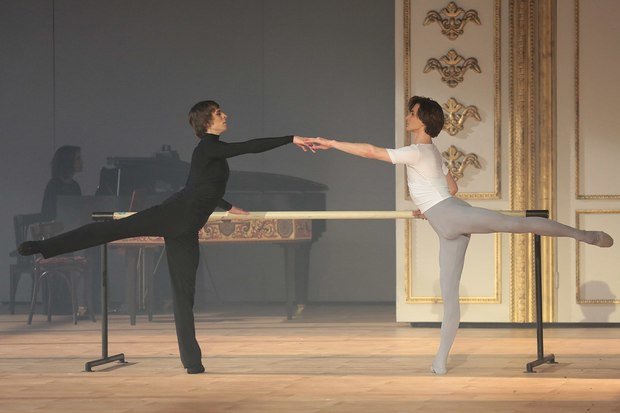
Nureyev by Serebrennikov looks selfish, contemptuous of colleagues on stage and preoccupied exceptionally with career. At the beginning of the second act, to the hauteur from ballet it is dedicated a long dance etude. A certain group (perhaps, from those with whom the dancer met during their nonstop tours, and maybe the troupe of the Paris Opera, which he directed and which he nurtured, discovering in the ranks of the corps de ballet amazing talents) of dressed in black ballerinas and dressed in costumes of Nureyev roles cavaliers rehearse or perform a play, constantly interrupted by the angry cries of the protagonist, alternately snatching from colleagues female partners for himself. ''They come to see me, not you!'' screams the genius, and this philippic is perceived as his main characteristic.
From here — to the pre-final picture, called by the librettist as 'The Sun King' and representing a pompous parade of characters in red-and-gold baroque costumes. Like the triumph of the ballet king, bending the world to his will by the power of exquisite dance and — read from the play – by obnoxious character of the conqueror who violated the boundaries of conceivable freedom.
Nothing similar to reflections, no frank confessions, or loneliness emerging through the glamorous tinsel of social events — nothing that allows to explore the complex and contradictory life of one of the largest ballet artists of our time in the created by Serebrennikov figure, alas, is read until it started and then ragged monologue by Pierrot Lunaire to the music by Arnold Schoenberg (the paraphrase to the same performance by the Danish Royal ballet, choreography by Glen Tetley) and the final picture of the play. Only Tatar song of the so-called Singer of the King and the epilogue give birth to a live emotion, and, from my point of view, reconcile numerous contradictions in the hasty assembling of the play show or the play-revue.
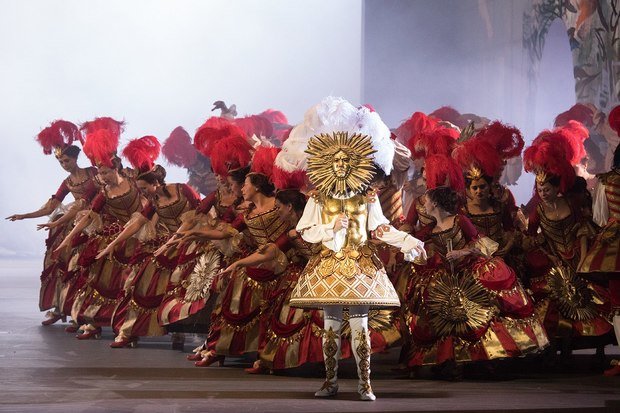
Sad 'Shadows'
To the music by Ludwig Minkus, multiplying the famous arabesques by Marius Petipa, on the stage there appear the shadows from the ballet La Bayadere — the latest production staged by Nureyev at the Paris Opera on the stage of the Palais Garnier. The assistants are taking Nureyev, dressed in evening dress and the famous turban, to the front of the stage. He descends into the orchestra pit and stands behind the podium, from where he conducts this farewell dance as if climbing to the tops of snow-covered Himalayan mountains, where he meets the shadows of those with whom the fate brought him. Here, as they say, to the lump in my throat, and here — almost pure ballet on the freed for ballet stage, cluttered with a long-term biopic on the faces.
What do we have in the result? In the end, the Bolshoi Theatre offers an interesting experience of the ballet, staged on-site of the musical and inheriting the ideas of the pioneer of the genre — Matthew Bourne, known for his turnings of classical ballets into musical manner. But Serebrennikov, who tried to make such a transfer from one genre to another, to mix on the palette of diverse colours, created an unusual for the historic scene of the Bolshoi Theatre play, where the chosen for the biographical text language of the musical works flawlessly.
By rhythm, rearrangements of drama, musical material by Ilya Demutsky, liberally quoting fragments of musical scores — from Tchaikovsky to Mahler and Schoenberg — to Minkus, and by peculiar to the Broadway genre irony, not esteeming lyrics and drama and slightly straightening the characters, but inevitably bringing the story to the level of well-structured digest, interesting to any recipient.
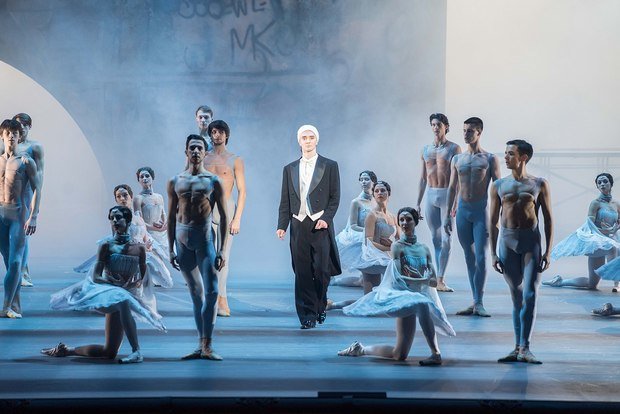
As for reflections and thoughts, nobody in the future will look at the biography of Nureyev and his work with a more intent and penetrating glance. First of all, on the history in it, where there is love of Rudy and Margot and the collapsed world of one without the other — the one about whom he said, ''She is the only one I have in the whole world.''